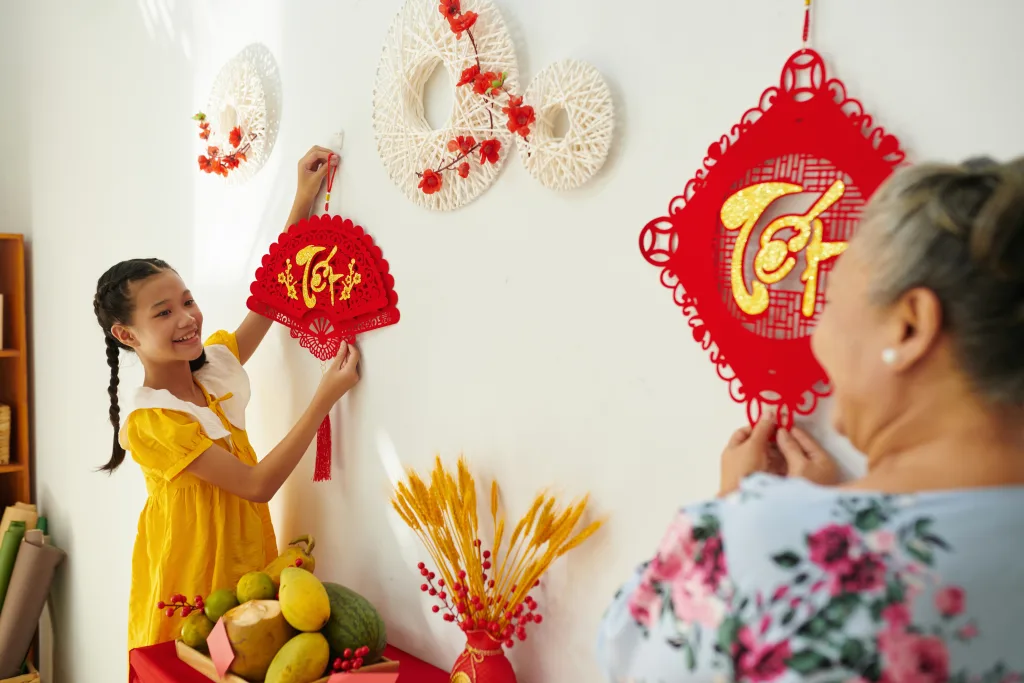Tết, also known as the Vietnamese Lunar New Year, is a cherished celebration of gratitude, family, and renewal. Typically falling between late January and mid-February, Tết marks the start of the lunar calendar, bringing vibrant customs and meaningful practices that connect generations and welcome good fortune.
As one of the most significant holidays in Vietnam, Tết offers a chance to reflect on the past year, honor ancestors, and embrace new beginnings. Exploring Tết traditions is a wonderful way to immerse your family in Vietnamese culture. Whether you’re hosting an Au Pair or simply seeking to learn about Vietnamese Tết traditions, these activities provide fun and meaningful opportunities to bond as a family while embracing the spirit of the holiday.
Understanding Tết: A Time for Renewal and Gratitude
Tết, or Vietnamese New Year, is deeply rooted in history and spirituality. It dates back nearly 4,000 years and has evolved into a weeklong celebration that marks the arrival of spring and a fresh start. Families honor Tết Vietnamese New Year traditions through cleaning, cooking, decorating, and sharing time together.
At its heart, Tết is a time for reflection and renewal—a chance to sweep away negativity, celebrate with loved ones, and express gratitude to ancestors. Each tradition carries symbolic meaning, making this holiday a truly enriching experience.
5 Essential Tết Traditions to Celebrate as a Family
Tết traditions are filled with symbolic practices that bring families together and set the tone for a prosperous new year. From preparing your home to sharing festive meals, these customs create meaningful opportunities to bond, reflect, and embrace the spirit of Vietnamese Lunar New Year. Here are some simple yet impactful ways to celebrate with your family.
1. Cleaning and Decorating Your Home
One of the most widely observed Tết traditions is preparing the home for a fresh start. Families clean their homes to sweep away bad luck and make space for prosperity. After tidying, they decorate with items that symbolize good fortune, such as:
- Peach blossoms (Hoa Đào): Representing love and renewal.
- Apricot blossoms (Hoa Mai): Symbolizing wealth and happiness.
- Kumquat trees: Signifying abundance and fertility.
Involve your children by letting them help tidy and decorate. This makes the tradition hands-on and enjoyable while teaching them about the meaning behind these festive symbols.
2. Cooking Traditional Vietnamese Foods
Food is a central part of Vietnamese Tết traditions. Families come together to prepare dishes that symbolize unity, prosperity, and love. Try making these iconic dishes as a family:
- Bánh Chưng: Square sticky rice cakes wrapped in banana leaves, filled with glutinous rice, mung beans, and pork. These cakes represent the earth and family unity.
- Bánh Tét: Cylindrical rice cakes symbolizing the sky and the passage of time. Like Bánh Chưng, they’re often prepared as a group activity.
- Thịt Kho Tàu: Braised pork and eggs simmered in a sweet-salty sauce, symbolizing comfort and family warmth.
Let your Vietnamese Au Pair share their knowledge of these recipes and teach your family how to prepare them. Cooking together fosters connection and allows everyone to enjoy the rich flavors of Tết.
3. Honoring Ancestors
Expressing gratitude to ancestors is a cornerstone of Tết Vietnamese New Year traditions. Families set up altars with offerings of food, flowers, and incense to honor their heritage and maintain a connection between past and present generations.
Encourage your children to participate by helping prepare the altar or writing notes of thanks. This is a meaningful way to teach respect and gratitude for those who came before us.
4. Sharing Red Envelopes (Lì Xì)
Giving red envelopes filled with money is a beloved Vietnamese Tết tradition. These envelopes symbolize good fortune and blessings for the year ahead. Traditionally given to children and elders, this practice brings joy and excitement to the celebration.
To incorporate this tradition into your family’s Tết celebration:
- Let your children design and decorate their own red envelopes.
- Fill them with small amounts of money or tokens of appreciation.
- Share them during your family meal or a festive gathering.
5. Playing Traditional Games and Activities
Tết is a time for joy and togetherness, and traditional games bring families closer while adding excitement to the festivities. Popular activities include:
- Bầu Cua Cá Cọp (Gourd-Crab-Fish-Tiger Dice Game): A luck-based game involving dice and animal-themed betting.
- Lô Tô (Vietnamese Bingo): A fun and familiar activity for all ages.
- Đập Niêu Đất (Breaking the Clay Pot): Blindfolded participants try to smash a pot filled with treats, guided by cheers and laughter.
Host a family game night to experience the fun and tradition of Tết together.
Reflecting on Tết Traditions with Your Au Pair
After celebrating Tết, take time to reflect on the experience. Ask your children and Au Pair to share their favorite parts of the holiday, and discuss the values behind the traditions you practiced. This is an opportunity to foster cultural appreciation and build lasting connections.
Questions for reflection:
- What was your favorite activity or dish from Tết?
- How do Tết traditions compare to the holidays we celebrate?
- Which traditions should we include in next year’s celebration?
Encouraging these conversations deepens understanding and makes the experience more memorable for everyone.
Building Bonds Through Cultural Exchange
Celebrating Vietnamese Tết traditions is an opportunity to embrace cultural diversity and strengthen family bonds. Hosting an Au Pair from Vietnam or another country introduces your family to meaningful customs and teaches your children to value global perspectives.
Ready to experience the joys of cultural exchange? Find your ideal Au Pair today and create new traditions that will enrich your family for years to come.




